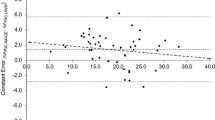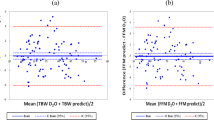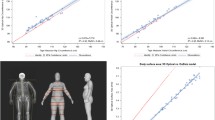Abstract
Background
This study aimed to develop estimation formulae for the total human body volume (BV) of adult males using anthropometric measurements based on a three-dimensional (3D) scanning technique. Noninvasive and reliable methods to predict the total BV from anthropometric measurements based on a 3D scan technique were addressed in detail.
Methods
A regression analysis of BV based on four key measurements was conducted for approximately 160 adult male subjects. Eight total models of human BV show that the predicted results fitted by the regression models were highly correlated with the actual BV (p < 0.001).
Results
Two metrics, the mean value of the absolute difference between the actual and predicted BV (V error) and the mean value of the ratio between V error and actual BV (RV error), were calculated. The linear model based on human weight was recommended as the most optimal due to its simplicity and high efficiency.
Conclusions
The proposed estimation formulae are valuable for estimating total body volume in circumstances in which traditional underwater weighing or air displacement plethysmography is not applicable or accessible.
Level of Evidence IV
This journal requires that authors assign a level of evidence to each article. For a full description of these Evidence-Based Medicine ratings, please refer to the Table of Contents or the online Instructions to Authors www.springer.com/00266.



Similar content being viewed by others
References
Lou HY (2005) Optimal selection of the body volume calculative model in male college students. Chin J Clin Rehabil 40:134–136
Wang J, Gallagher D, Thornton JC, Yu W (2006) Validation of a 3-dimensional photonic scanner for the measurement of body volumes, dimensions, and percentage body fat. Am J Clin Nutr 83:809–816
Heymsfield SB, Childers D, Beetsch J, Allison DB, Pietrobelli A (2007) Body size and human energy requirements: reduced mass-specific resting energy expenditure in tall adults. J Appl Physiol 103:1543–1550
Witana CP, Xiong S, Zhao J, Goonetilleke RS (2006) Foot measurements from three-dimensional scans: a comparison and evaluation of different methods. Int J Ind Ergon 36:789–807
Pouliot MC, Després JP, Lemieux S (1994) Waist circumference and abdominal sagittal diameter: best simple anthropometric indexes of abdominal visceral adipose tissue accumulation and related cardiovascular risk in men and women. Am J Cardiol 73:460–468
Bolton MA, Pruzinsky T, Cash TF, Persing JA (2003) Measuring outcomes in plastic surgery: body image and quality of life in abdominoplasty patients. Plast Reconstr Surg 112:619–625
Pirker K (2008) Measuring human body volume for segmental impedance measurement in a clinical environment. M.S. Thesis, Graz University of Technology, Styria, Austria
小森 慎也, 武田 賢, 土橋 卓 (2014) Clinical factors relevant to regional body volume changes during radical external radiotherapy for head and neck cancer (in Japanese). 臨床放射線 59:733–739
Hedén P, Sellman G, Von WM, Olenius M, Fagrell D (2009) Body shaping and volume restoration: the role of hyaluronic acid. Aesthetic Plast Surg 33:274–282
Tahrani A, Boelaert K, Barnes R, Palin S, Field A, Redmayne H (2008) Body volume index: time to replace body mass index? Endocr Abstr 15:104
Behnke AR, Feen BG, Welham WC (1942) The specific gravity of healthy men: body weight volume as an index of obesity. J Am Med Assoc 3(3):295–300
Brožek J, Keys A (1951) The evaluation of leanness-fatness in man: norms and interrelationships. Br J Nutr 5:194–206
Durnin JVGA, Rahaman MM (1967) The assessment of the amount of fat in the human body from measurements of skinfold thickness. Br J Nutr 21:681–689
Pascal LR, Grossman MI, Sloane HS, Frankel T (1956) Correlations between thickness of skinfolds and body density in 88 soldiers. Hum Biol 28:165
Sloan AW (1967) Estimation of body fat in young men. J Appl Physiol 23:311–315
Wilmore JH, Behnke AR (1969) An anthropometric estimation of body density and lean body weight in young men. J Appl Physiol 27:25–31
Verma SS, Bharadwaj H, Zachariah T, Kishnani S, Bhatia MR (1983) Prediction of body volume by a stepwise linear regression technique. Eur J Appl Physiol 52:126–130
Nakadomo F, Tanaka K, Watanabe K, Mitani H (1992) Human body volume measurement by sulfur hexafluorde-dilution method and its application to human body composition assessment. Ann Physiol Anthropol = Seiri Jinruigaku Kenkyukai kaishi 11:461–470
Huang KL, Chien PS, Kishi Y, Lin YC (1994) Application of conservation principle in estimating body volume in rats. J Appl Physiol 76:391–396
Hohl R, de Oliveira RB, de Macedo DV, Brenzikofer R (2007) Apparatus for measuring rat body volume: a methodological proposition. J Appl Physiol 102:1229–1234
Buskirk ER (1961) Underwater weighing and body density: a review of procedures. In: Brozek J, Henschel A (eds) Techniques for measuring body composition. National Academy of Sciences, National Research Council, Washington, DC, pp 90–105
Wang J, Thornton JC, Kolesnik S, Pierson RN (2000) Anthropometry in body composition: an overview. Ann N Y Acad Sci 904:317–326
Lu JM, Wang MJ (2008) Automated anthropometric data collection using 3D whole body scanners. Expert Syst Appl 35:407–414
Resource A (2007) Final Report, Volume I: Summary. AFRL-HE-WP-TR-2002-0169, United States Air Force Research Laboratory, Human Effectiveness Directorate, Crew System Interface Division, 2255 H Street, Wright-Patterson AFB OH 45433-7022 and SAE International, 400 Commonwealth Dr., Warrendale, PA 15096
Niu J, Li Z, Salvendy G (2009) Multi-resolution shape description and clustering of three-dimensional head data. Ergonomics 52:251–269
Isaacs M (2005) 3D fit for the future-3D fit and design can be the solution to several industry problems. AATCC Rev-Am Assoc Text Chem Color 5:21–24
Li Z, Chang CC, Dempsey PG, Ouyang L, Duan J (2008) Validation of a three-dimensional hand scanning and dimension extraction method with dimension data. Ergonomics 51:1672–1692
Brooke-Wavell K, Jones PRM, West GM (1994) Reliability and repeatability of 3-D body scanner (LASS) measurements compared to anthropometry. Ann Hum Biol 21:571–577
Lee HY, Huang KW, Jou GT (2001) The verification of measurement extracted from 3D (three-dimensional) scanned against manual data. In Proceedings of the 6th Asian textile conference, August 22–24
Wang MJJ, Wu WY, Lin KC, Yang SN, Lu JM (2007) Automated anthropometric data collection from three-dimensional digital human models. Int J Adv Manuf Technol 32:109–115
Lohman TJ, Roache AF, Martorell R (1992) Anthropometric standardization reference manual. Med Sci Sports Exerc 24:952
Daanen HA, Brunsman MA, Robinette KM (1997) Reducing movement artifacts in whole body scanning. In: 3-D digital imaging and modeling, 1997. Proceedings., international conference on recent advances in IEEE, 262–265
O’Rourke N, Hatcher L (2013) A step-by-step approach to using SAS for factor analysis and structural equation modeling. Sas Institute 83:325–326
Hentschel M, Paul D, Korsten-Reck U, Mix M, Müller F, Merk S (2005) Can body volume be determined by PET. Eur J Nucl Med Mol Imaging 32:564–568
Collins AL, Saunders S, McCarthy HD, Williams JE, Fuller NJ (2004) Within-and between-laboratory precision in the measurement of body volume using air displacement plethysmography and its effect on body composition assessment. Int J Obes 28:80–90
Krzywicki HJ, Chinn KS (1967) Human body density and fat of an adult male population as measured by water displacement. Am J Clin Nutr 20:305–310
Liu C, Ji K, Sun J, Luan J (2014) Does respiration influence breast volumetric change measurement with the three-dimensional scanning technique? Aesth Plast Surg 38(1):115–119
Koch MC, Adamietz B, Jud SM, Fasching PA, Haeberle L, Karbacher S, Veit K, Schulz-Wendtland R, Uder M, Beckmann MW, Bani MR, Heusinger K, Loehberg CR, Cavallaro A (2011) Breast volumetry using a three-dimensional surface assessment technique. Aesth Plast Surg 35(5):847–855
Author information
Authors and Affiliations
Corresponding author
Ethics declarations
Conflict of interest
The authors declare that they have no conflicts of interest to disclose.
Ethical Approval
All procedures performed in studies involving human participants were in accordance with the ethical standards of the institutional and/or national research committee and with the 1964 Helsinki Declaration and its later amendments or comparable ethical standards.
Rights and permissions
About this article
Cite this article
Liu, X., Niu, J., Ran, L. et al. Estimation of Human Body Volume (BV) from Anthropometric Measurements Based on Three-Dimensional (3D) Scan Technique. Aesth Plast Surg 41, 971–978 (2017). https://doi.org/10.1007/s00266-017-0872-5
Received:
Accepted:
Published:
Issue Date:
DOI: https://doi.org/10.1007/s00266-017-0872-5




